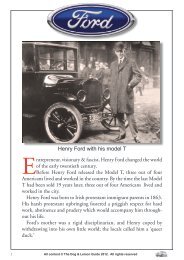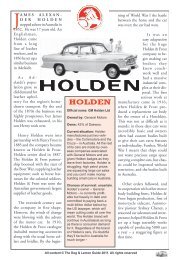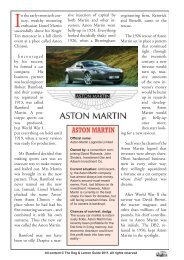You lose around 40% in the first year - The Dog and Lemon Guide
You lose around 40% in the first year - The Dog and Lemon Guide
You lose around 40% in the first year - The Dog and Lemon Guide
Create successful ePaper yourself
Turn your PDF publications into a flip-book with our unique Google optimized e-Paper software.
Depreciation<br />
<strong>in</strong> <strong>the</strong> UK<br />
<strong>You</strong> <strong>lose</strong> <strong>around</strong> <strong>40%</strong> <strong>in</strong> <strong>the</strong> <strong>first</strong> <strong>year</strong><br />
It’s true: <strong>the</strong> value of your car plummets <strong>the</strong> moment you drive it off <strong>the</strong><br />
forecourt. <strong>The</strong> average new car <strong>in</strong> <strong>the</strong> UK <strong>lose</strong>s about <strong>40%</strong> <strong>in</strong> <strong>the</strong> <strong>first</strong> <strong>year</strong>.<br />
<strong>The</strong>n <strong>the</strong> depreciation eases off to a more manageable level of about 10% per<br />
annum, assum<strong>in</strong>g you drive <strong>around</strong> 10,000 miles per <strong>year</strong>.<br />
That’s why <strong>the</strong> smart new car buyer will choose a car that’s already a <strong>year</strong> or<br />
so old: that way, <strong>the</strong> depreciation monster will have already taken its biggest<br />
bite, but <strong>the</strong>re will still be plenty of new-car guarantee left.<br />
Whichever way you look at it, however, depreciation is a depress<strong>in</strong>g bus<strong>in</strong>ess:<br />
after four <strong>year</strong>s, <strong>the</strong> average car will be worth just <strong>40%</strong> of its orig<strong>in</strong>al value.<br />
That is, your £10,000 new car is now worth £4000. Ouch.
However, not all cars depreciate equally: depreciation <strong>in</strong> <strong>the</strong> UK is a relatively<br />
simple equation of desirability plus practicality. If you have a vehicle that<br />
people desire, <strong>and</strong> it’s thought of as practical, depreciation is lower <strong>and</strong> slower.<br />
If you have a vehicle that’s impractical but desirable, depreciation is a bit lower,<br />
but not as low as on a vehicle that’s both desirable <strong>and</strong> practical. If you have a<br />
vehicle that’s nei<strong>the</strong>r desirable nor practical, you’re <strong>in</strong> trouble: few buyers will<br />
want it <strong>and</strong> <strong>the</strong>y won’t pay much for it, even if it’s a relatively new vehicle.<br />
Desirable, by <strong>the</strong> way, doesn’t always mean high <strong>in</strong> status or looks (although<br />
it can, <strong>in</strong> certa<strong>in</strong> circumstances). It simply means that people want one of <strong>the</strong>se<br />
vehicles. For example, <strong>the</strong> Daihatsu Terios, Audi Q5 <strong>and</strong> Volvo XC60 all hold<br />
<strong>the</strong>ir value a bit better than <strong>the</strong> average car.<br />
Before you rush out <strong>and</strong> buy an Audi Q5, however, be aware that <strong>the</strong>y still<br />
plummet <strong>in</strong> value, just like everyth<strong>in</strong>g else, After four <strong>year</strong>s, <strong>the</strong> Q5 will have<br />
lost <strong>around</strong> half its value. That’s better than average, but still vicious.<br />
Why do <strong>the</strong> Daihatsu Terios, Audi Q5 <strong>and</strong> Volvo XC60 all hold <strong>the</strong>ir value<br />
better than average? <strong>The</strong> answer is that pretend offroaders like <strong>the</strong>se three are<br />
<strong>the</strong> estate cars of <strong>the</strong> early 21st century. Buyers believe <strong>the</strong>m to be a practical<br />
option. Plus, depend<strong>in</strong>g on your peer group, you may be admired for own<strong>in</strong>g<br />
one. That’s right. <strong>The</strong> typical Daihatsu Terios owner takes a fierce pride <strong>in</strong> mak<strong>in</strong>g<br />
a practical choice. <strong>The</strong>y (<strong>and</strong> <strong>the</strong>ir friends) probably hate Jeremy Clarkson<br />
<strong>and</strong> <strong>the</strong>y lament <strong>the</strong> fact that shows like TopGear tend to promote impractical,<br />
expensive vehicles. Buy a Terios <strong>and</strong> you’re part of a fiercely proud peer group<br />
who take pride <strong>in</strong> <strong>the</strong>ir unfashionable, practical, affordable vehicles.<br />
<strong>The</strong>se days, a ‘practical’ vehicle must generally give decent fuel economy, be<br />
easily useable on <strong>the</strong> daily commute <strong>and</strong> also be reasonably reliable.<br />
However, <strong>the</strong> depreciation figures don’t tell <strong>the</strong> full story: vehicles like <strong>the</strong><br />
Mazda MX-5 (about 37%<br />
depreciation <strong>in</strong> <strong>the</strong> <strong>first</strong><br />
<strong>year</strong>), <strong>and</strong> Lamborgh<strong>in</strong>i<br />
Gallardo (just over <strong>40%</strong><br />
depreciation <strong>in</strong> <strong>the</strong> <strong>first</strong><br />
<strong>year</strong>) may seem similar <strong>in</strong><br />
<strong>the</strong>ir loss of value, but <strong>the</strong><br />
situation with expensive<br />
<strong>and</strong> impractical vehicles is<br />
even worse than it sounds.<br />
LAMBORGHINI GALLARDO<br />
A high-status vehicle, but it <strong>lose</strong>s over £100,000 <strong>in</strong> value<br />
<strong>in</strong> just four <strong>year</strong>s.
If you can’t get a decent trade-<strong>in</strong> price on your four-<strong>year</strong>-old Mazda MX-5 at<br />
a dealer, it should be easy enough to f<strong>in</strong>d a private buyer on eBay. <strong>You</strong>r £21,500<br />
MX-5 is now worth just £7500, but <strong>the</strong>re are plenty of people who can lay<br />
<strong>the</strong>ir h<strong>and</strong>s on £7500 <strong>in</strong> cash; you shouldn’t have much trouble f<strong>in</strong>d<strong>in</strong>g a buyer.<br />
When you come to sell a vehicle like <strong>the</strong> Lamborgh<strong>in</strong>i Gallardo, however,<br />
you won’t f<strong>in</strong>d many buyers. <strong>You</strong> can’t just offer a Lamborgh<strong>in</strong>i Gallardo<br />
on eBay <strong>and</strong> pick up a buyer on Saturday morn<strong>in</strong>g. After four <strong>year</strong>s, your<br />
£170,000 quid Lambo is now worth less than £60,000, assum<strong>in</strong>g you can f<strong>in</strong>d<br />
a genu<strong>in</strong>e buyer with 60,000 quid <strong>in</strong> his pocket. Most private buyers can’t lay<br />
<strong>the</strong>ir h<strong>and</strong>s on £60,000, even though <strong>the</strong>y wish <strong>the</strong>y could. <strong>You</strong>’ll be beseiged<br />
by dreamers want<strong>in</strong>g to take your Lambo for a test drive, <strong>and</strong> people offer<strong>in</strong>g<br />
to swap <strong>the</strong>ir equally unsellable Ferrari or Rolls-Royce for your Lamborgh<strong>in</strong>i.<br />
Or <strong>the</strong>y’ll offer to take your Lambo as a deposit on <strong>the</strong>ir new property development;<br />
<strong>the</strong> one that <strong>the</strong> Fraud Squad is currently <strong>in</strong>vestigat<strong>in</strong>g. Genu<strong>in</strong>e buyers<br />
will probably be pretty th<strong>in</strong> on <strong>the</strong> ground.<br />
Instead, your only genu<strong>in</strong>e buyers will probably be car dealers. <strong>The</strong>y won’t<br />
give you cash, unless you’re prepared to sell for well under market value; almost<br />
certa<strong>in</strong>ly <strong>the</strong>y’ll try <strong>and</strong> take <strong>the</strong> Lambo as a trade-<strong>in</strong> on ano<strong>the</strong>r expensive car,<br />
so you’ll end up repeat<strong>in</strong>g this cycle of endless loss. Worse, if you’re <strong>in</strong> a hurry<br />
to sell, or you don’t want to buy an expensive car <strong>in</strong> place of an expensive car,<br />
you’re probably go<strong>in</strong>g to end up cutt<strong>in</strong>g your losses <strong>and</strong> sell<strong>in</strong>g at an awful loss<br />
anyway.<br />
Also high up <strong>the</strong> ‘hit-hard-by-depreciation’ list is any sporty model that has<br />
a poor reputation for durability. For example, <strong>the</strong> Alfa Romeo 159 <strong>lose</strong>s a cool<br />
50% <strong>in</strong> its <strong>first</strong> <strong>year</strong> <strong>and</strong> is worth <strong>around</strong> 25% of its orig<strong>in</strong>al value after four<br />
<strong>year</strong>s.<br />
Mileage is a huge issue on any vehicle: not only do low-mileage vehicles tend<br />
to look <strong>and</strong> feel better, but also <strong>the</strong>y’re generally more reliable. <strong>The</strong>refore, <strong>the</strong><br />
lower <strong>the</strong> mileage, <strong>the</strong> less deprecation. However, low mileage won’t save you if<br />
you buy an impractical car with a<br />
poor reputation.<br />
Partially due to badge snobbery,<br />
<strong>the</strong> desirability of any particular<br />
model tends to nosedive once a<br />
new model is released (badge snobs<br />
have to have <strong>the</strong> latest model). So,<br />
if you buy, say, a VW Polo just<br />
ALFA ROMEO 159<br />
Lost 50% of its value <strong>in</strong> <strong>the</strong> <strong>first</strong> <strong>year</strong>.
efore a new model is released, it will depreciate far faster than <strong>the</strong> newer model.<br />
That’s why car dealers often offer discounts on <strong>the</strong> last versions of an older<br />
model. <strong>The</strong>se cars seem attractive: however, if you’re not careful, <strong>the</strong> discount<br />
won’t be as much as your own losses due to depreciation.<br />
If you had waited a <strong>year</strong> <strong>and</strong> bought a low-mileage one-<strong>year</strong> old version of<br />
<strong>the</strong> same car, you might get it at, say, £6000. That’s much smarter buy<strong>in</strong>g. After<br />
a <strong>year</strong>, your vehicle has lost ano<strong>the</strong>r, say, 10%, so it’s now worth £5400. <strong>You</strong>’ve<br />
lost £600 <strong>in</strong>stead of £4600 (£10,000 m<strong>in</strong>us <strong>40%</strong> <strong>in</strong> <strong>the</strong> <strong>first</strong> <strong>year</strong> m<strong>in</strong>us 10% <strong>in</strong><br />
<strong>the</strong> second <strong>year</strong>).<br />
By <strong>the</strong> way, don’t fall for <strong>the</strong> salesman’s l<strong>in</strong>e that desirable vehicles hold <strong>the</strong>ir<br />
value because (he says) so many punters are after <strong>the</strong> same type of car. It does<br />
happen, about that same number of times you f<strong>in</strong>d an honest politician. At<br />
best, your ‘desirable’ vehicle will <strong>lose</strong> its value a little slower than average, that’s<br />
all. Go back after a <strong>year</strong> <strong>and</strong> ask <strong>the</strong> salesman to buy it back for <strong>the</strong> same price<br />
you paid for it <strong>and</strong> he’ll laugh <strong>in</strong> your face.<br />
If you own a vehicle that’s nei<strong>the</strong>r desirable nor practical, <strong>the</strong> value plummets.<br />
Luxury cars, by <strong>the</strong>ir very nature, are desirable when new <strong>and</strong> less desirable<br />
when old (unless <strong>the</strong>y’re old enough to be a classic). Strangely enough, <strong>the</strong><br />
more you pay for a new vehicle, <strong>the</strong> less practical it generally is: luxury cars like<br />
<strong>the</strong> Rolls-Royce Phantom are notoriously thirsty, not especially reliable, as well<br />
as be<strong>in</strong>g next-to-impossible to park <strong>in</strong> t<strong>in</strong>y urban park<strong>in</strong>g spaces. Luxury cars<br />
quickly <strong>lose</strong> <strong>the</strong>ir status (<strong>and</strong> <strong>the</strong>refore desirability) as <strong>the</strong>y cease to be new. Are<br />
you driv<strong>in</strong>g a five-<strong>year</strong>-old Rolls-Royce Phantom? As far as <strong>the</strong> rich <strong>and</strong> snobbish<br />
are concerned, you’re simply advertis<strong>in</strong>g <strong>the</strong> fact that you can’t afford a<br />
newer model. Humph.<br />
If you have an expensive, impractical vehicle that never really connected with<br />
<strong>the</strong> car-buy<strong>in</strong>g public, that’s <strong>the</strong> worst possible comb<strong>in</strong>ation. If you paid <strong>around</strong><br />
£370,000 for your Mercedes Maybach, your depreciation would have been<br />
50% or so <strong>in</strong> <strong>the</strong> <strong>first</strong> <strong>year</strong>. By four<br />
<strong>year</strong>s old <strong>the</strong> Maybach would be worth<br />
<strong>around</strong> 30% of what you paid for it,<br />
assum<strong>in</strong>g you could f<strong>in</strong>d a buyer,<br />
So, <strong>the</strong> moral of <strong>the</strong> story is: to<br />
avoid <strong>the</strong> depreciation monster, buy a<br />
car that’s both loveable <strong>and</strong> practical<br />
<strong>and</strong> more than a <strong>year</strong> old. Any o<strong>the</strong>r<br />
scenario will probably have an unhappy<br />
end<strong>in</strong>g •<br />
TOYOTA COROLLA / AURIS<br />
Practical vehicles still <strong>lose</strong> value from new, but<br />
tend to hold <strong>the</strong>ir value better as <strong>the</strong>y age.






